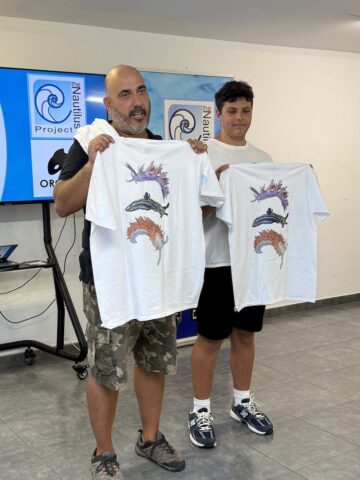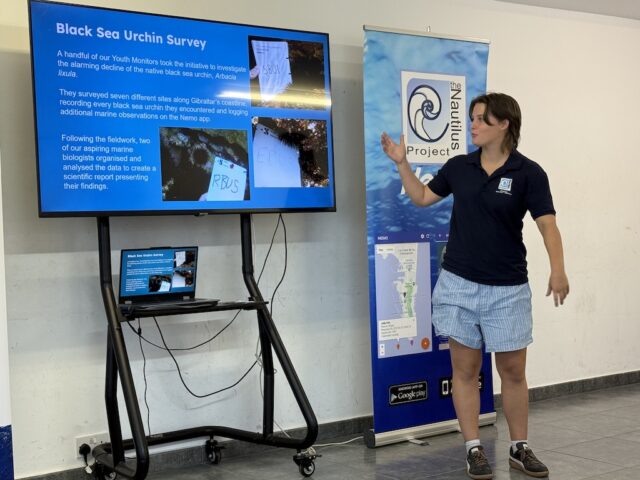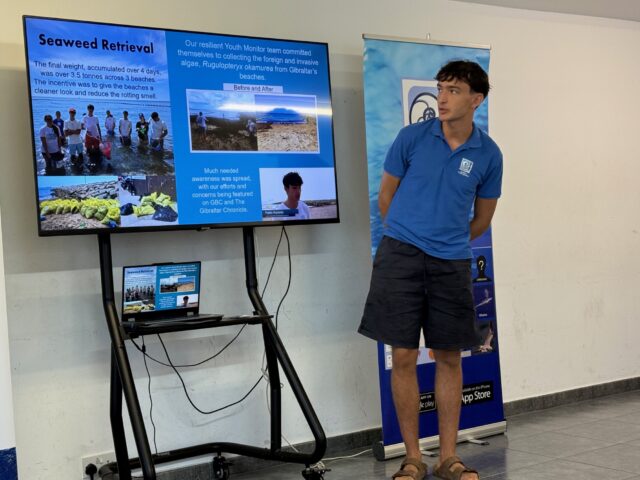Seagrass restoration and seaweed removal projects presented by youth monitors
Photos by Eyleen Gomez
The end of summer The Nautilus Project Youth Monitors ceremony was held at The Boathouse on Friday morning.
The program, now in its third year, brought together young people to participate in a series of hands-on activities, scientific investigations, and community outreach efforts aimed at preserving Gibraltar’s unique coastal and marine ecosystems.
The ceremony opened with a dance set to a speech from Sir David Attenborough, on with marine biologist Lewis Stagnetto remarking, “what I like about working with young people is that they open up that worldview, and you get to see it through fresh eyes all the time, if it's how to put a message across.”
“We've just seen a display of a dance, a very powerful dance in my opinion, that really transmits a message of that David Attenborough speech I've heard a thousand times, but transmitted in a new light, in a new way that perhaps we haven't thought of.”
“And actually, in order to get out of this climate mess, this is exactly the sort of thing we need. We need the youth to come through.”
“And in some ways, all we are really is facilitators trying to build that next generation.”
“And what a next generation we have coming through really, really talented people.”
The program’s activities were as diverse as they were impactful.
From marine biology workshops and beach clean-ups to kayaking expeditions and scientific surveys, participants were immersed in the natural world and encouraged to apply their unique talents.
“We have been working with them and advising them and helping them along the way, but this is their work,” said Mr Stagnetto.
Mr Stagnetto also presented two new t-shirt designs that have been created by Youth Monitor Dante Jimenez, with proceeds from the sale of these t-shirts going directly to TNP.

Youth leader Alex Sanchez Soiza explained that the work the Youth Monitors have done during the summer was an opportunity for young people to better understand Gibraltar’s coastline and to help students who want to go into the sciences but are not sure exactly what course they want to take in university.
He noted that there was the Kids Summer Camp, which ran from July 7 to 11 for children aged seven to eleven.
Each day offered a new adventure, including a marine biology workshop, a catch-and-release session, a beach clean, kayaking and stand-up paddleboarding, and a much-anticipated soccer trip. “They really enjoyed that one,” he said.
Collaboration was a key theme, with the program partnering with organisations such as MindSpace and welcoming a group from the UK called Thornleigh, explained youth monitor Mikey Rugeroni.
Together, they explored Gibraltar’s coastline, learned about marine life and participated in activities like scavenger hunts and lab work.
“At the end of the weeks, they compiled their data and created presentations showing what they learned, and I think that went very well,” he said.
“They showed loads of data, which was pretty useful and shows a lot about what we have here and how much they learned through us.”
Annie Ellul presented the feedback the group had received from Thornleigh, which was full of praise.
“Lots of people faced their fears, who continue to grow their passion for the love for the environment that they already had,” she said.

Emily Rees described a survey into the declining population of black sea urchins.
“We found 22 throughout the whole investigation, which is not many,” she said.
“After we completed the practical side, me and Finlay, an oceanographer and zoologist, wrote up a scientific report in the new teaching lab to have it written down, and then we could see certain patterns that there were and how the patterns we saw here were in keeping with a lot of scientific literature elsewhere.”
Environmental restoration was also on the programme, between the efforts to remove over 3.5 tons of invasive seaweed Rugulopteryx okamurea from local beaches to a new initiative to reintroduce the seagrass Posidonia Oceanica to Gibraltar’s waters.
The seaweed removal happened over four days, initially at Western beach, but also in Catalan Bay and Sandy Bay.

While the main task, Pablo Kussner explained, was the removal of the invasive species it was also to raise awareness.
“I think we did that fantastically. We spread a lot of awareness with being featured on GBC and in the Gibraltar Chronicle,” he said.
“And, as you can see, we had bags and bags and bags full. The total came to around over 3.5 tons of seaweed removed from the coastline, and that was across, you know, only three beaches, and four days.”

Finlay Savignon Watson spoke about the seagrass restoration programme.
The seagrass “provided a really integral habitat for species such as sea horses, which now are very, very rare in Gibraltar. I personally have never seen one, and I've been snorkelling many, many times,” he said.
“So what we intend to do is begin raising sea grass in a nursery. We’re getting it from Malta, the seedlings, and we're bringing it to a lab which, over the course of this year, we have been monitoring to ensure that it all works correctly before we import the seagrass.”
“We're monitoring it for a full year, so that we can see how all the electronics and the plumbing all fares during all types of weather and climate that we could have across a year, so that we don't get the sea grass, plant it, and then it fails and it will die.”
“We intend on reintroducing it back into Gibraltar's waters once we've grown them to a substantial size and reintroducing the habitat that we've lost in Gibraltar.”
The Chief Executive of the Department of the Environment, Stephen Warr, was one of the dignitaries present.
He said, “It never ceases to amaze me, the excellent work that The Nautilus Project does.”
“I remember when I was 15/16, there was only a handful of people working in terms of the environmental activism group back then, but It's so reassuring that we now have The Nautilus project under the leadership of Lewis and Melanie with so many young people.”
“I mean, you're certainly making my job easier moving forward.”
“And part of the work that I do is implementing environmental policies, policies which sometimes may be difficult for the public to understand, but if we now have the new generation up and coming who actually have the environmental at heart, it's certainly going to make my job in the future much easier when we need to implement environmental policies which might not be very easy to assimilate.”
“So, from the bottom of my heart, thank you very much for the work that you do. I hope that you continue doing what you do.”
“Stay strong, keep it up, and there is certainly a new hope in our next generation.”









